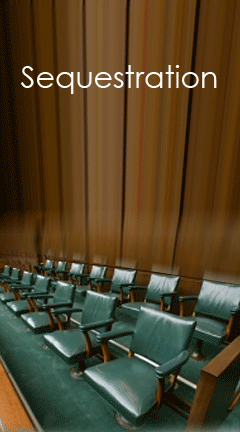Archival Notice
This is an archive page that is no longer being updated. It may contain outdated information and links may no longer function as originally intended.
Home | Glossary | Resources | Help | Course Map
A typical motion at trial is for all witnesses to be sequestered, that is, to be kept out of the courtroom while all other evidence is presented. The theory of sequestration is simple: By isolating the witnesses, no witness will hear the questions posed and answers given by others, or attempt to conform to the others' testimony.
A typical sequestration order directs the witnesses to remain out of the courtroom and not to discuss their testimony with others until the trial has concluded.
There are exceptions to the order of sequestration. In many jurisdictions, the case agent or lead investigator is permitted to remain in the courtroom throughout the trial, even though the investigator will also have a role as a testifying witness.
In some cases, judges will permit expert witnesses to remain during the testimony of others — as experts are permitted to comment on facts adduced from other witnesses — and to address the contentions of opposing experts.
Finally, the accused person in a criminal trial is never subject to a sequestration order, as criminal defendants have the constitutional right to be confronted by the witnesses against them.
There is no fixed rule that sets consequences for the violation of a sequestration order. Courts consider whether the violation was inadvertent or intentional, and the extent and duration of the violation. Consequences may range from an instruction, telling jurors to be aware of the violation when deciding the case, to the extreme sanctions of witness preclusion and contempt citations.
Additional Online Courses
- What Every First Responding Officer Should Know About DNA Evidence
- Collecting DNA Evidence at Property Crime Scenes
- DNA – A Prosecutor’s Practice Notebook
- Crime Scene and DNA Basics
- Laboratory Safety Programs
- DNA Amplification
- Population Genetics and Statistics
- Non-STR DNA Markers: SNPs, Y-STRs, LCN and mtDNA
- Firearms Examiner Training
- Forensic DNA Education for Law Enforcement Decisionmakers
- What Every Investigator and Evidence Technician Should Know About DNA Evidence
- Principles of Forensic DNA for Officers of the Court
- Law 101: Legal Guide for the Forensic Expert
- Laboratory Orientation and Testing of Body Fluids and Tissues
- DNA Extraction and Quantitation
- STR Data Analysis and Interpretation
- Communication Skills, Report Writing, and Courtroom Testimony
- Español for Law Enforcement
- Amplified DNA Product Separation for Forensic Analysts


